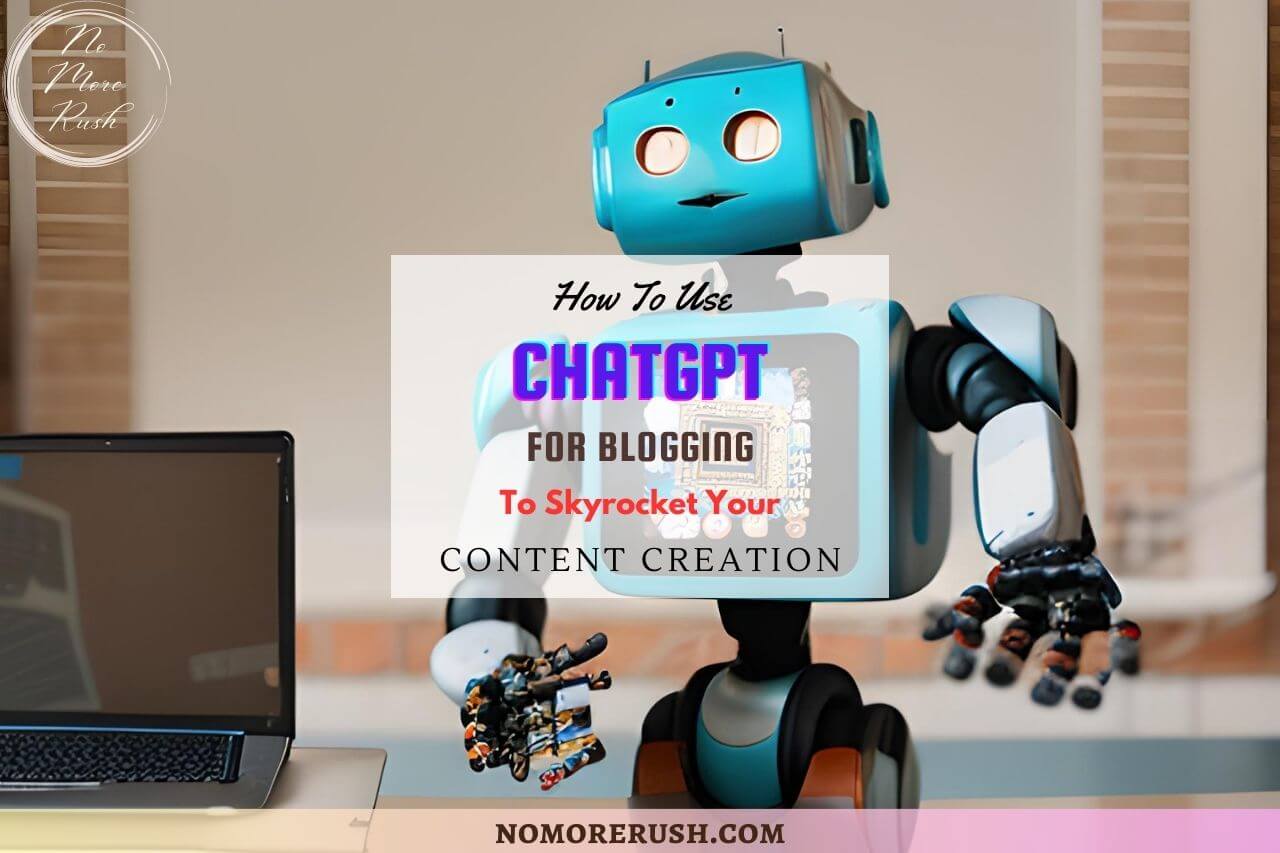Are you ready to take your blogging game to the next level? Well, hold onto your keyboards, because in this post I’m going to show you how to use ChatGPT for blogging to skyrocket your content creation process and your productivity through the roof.
If you’ve ever wished for a writing buddy who not only sparks brilliant blog post ideas but also helps you weave them into compelling pieces that readers can’t resist, then you’re in for a treat because ChatGPT is here to revolutionise the way you approach content creation.
I’ve been diving headfirst into the AI world over the last few months and trying out several AI Tools for blogging and I’ve been loving every minute of it.
The AI image-generating tools alone have completely blown my mind let alone the content-generating ones.
As for ChatGPT, this little chatbot (or “Gary” as I like to call it, and I know I’m not the only one who’s given theirs a name) has now become one of those tools that I couldn’t be without.
So with that in mind, I’m going to share with you why it’s become such a valuable tool and how you can use it to catapult your content creation to a whole new level. So are you ready? Let’s dive straight in!
How To Use ChatGPT For Blogging
If you haven’t already been playing around with ChatGPT then you’re going to have to create an account first to get started. So head to chat.openai.com where you’ll be prompted to create an account.
If you already have a Microsoft or Google account, then just use one of these to sign up. Once you’re signed in, you can choose to use either the free version (GPT-3.5) or the paid version (GPT-4.0) but for the sake of this post, I’ll be using the free version.
The paid version does have more functionality but GPT-3.5 should be more than adequate for most. Unfortunately, the free version can’t read links so you’ll need to paste entire articles if you want it to read entire blog posts but that’s a simple workaround.
To start using ChatGPT, you’ll need to enter prompts in the text box at the bottom of the screen which are simply instructions as to what you’d like ChatGPT to do.
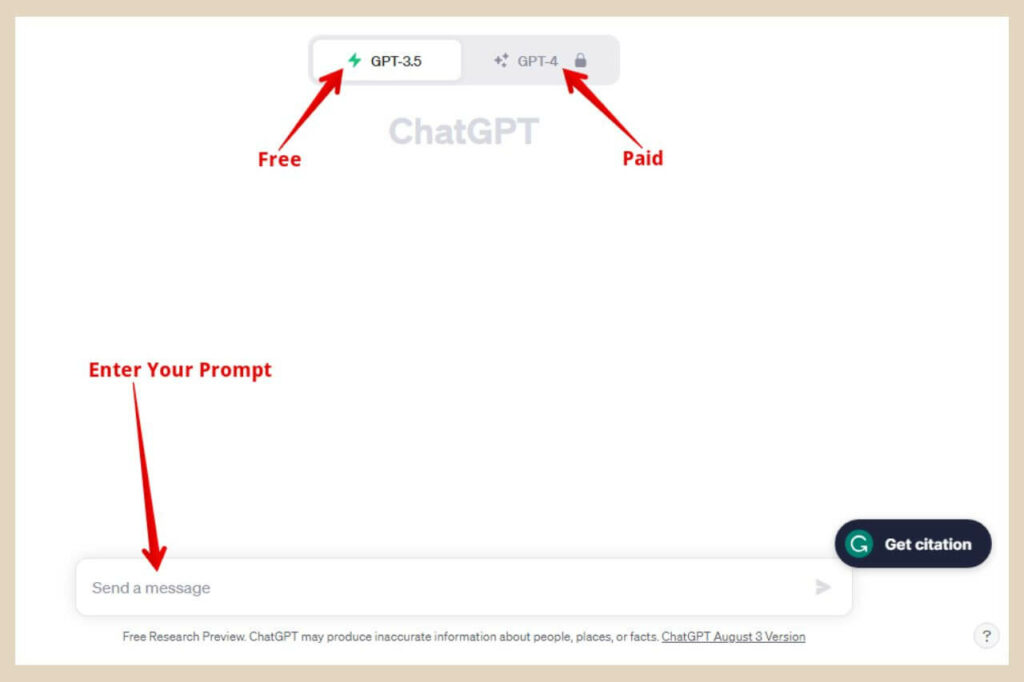
Now, You’re going to need to have a Google Doc or Google sheet ready to hand before you start because you’re about to be bombarded with an epic amount of content ideas. So, let’s do some brainstorming with ChatGPT and get those creative gears turning!
Brainstorming And Creating A Content Plan
It’s no secret that coming up with fresh and exciting blog post ideas can sometimes be a bit of a chore. But with ChatGPT at your disposal, you’ll be able to jumpstart your brainstorming sessions exponentially!
Imagine having a virtual idea generator that takes your niche and then delivers a list of potential blog post topics in a matter of seconds. Well, that’s exactly what ChatGPT can do and all you need to do is ask it
Simply ask it to suggest topic ideas in relation to your niche and it will instantly generate a list of related topics. You can even ask it to output a certain number of answers.

Let’s say you’re in the fitness niche, for example, and you want 10 topic ideas for your fitness blog. You could simply enter the following prompt to get things started.
Can you suggest 10 topic ideas for a fitness blog.
Obviously, you’d replace fitness with your own niche but from here, ChatGPT should give you 10 topic ideas that you can now use to find sub-topics.
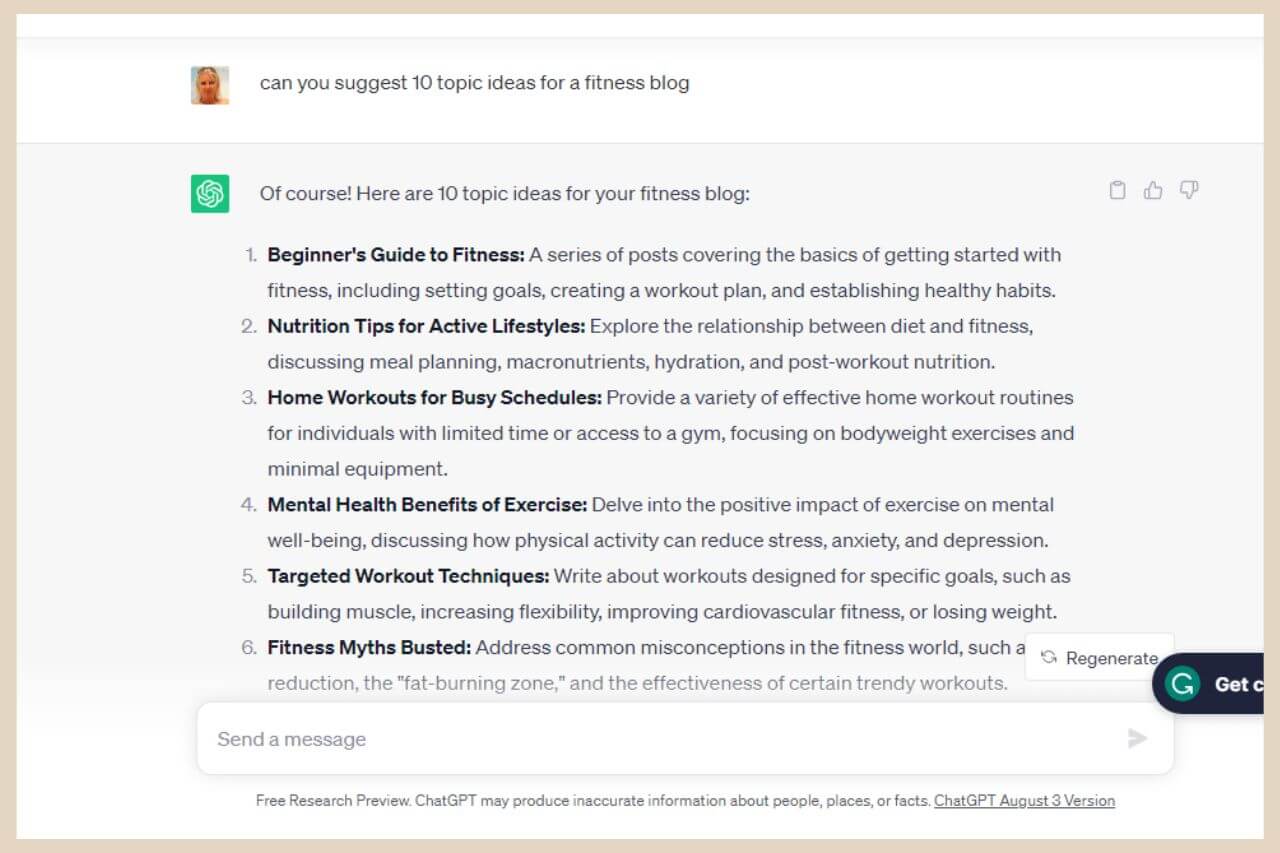
To find sub-topics, simply ask ChatGPT to suggest sub-topics for each of the 10 topics it just came up with. The best way to do this is one topic at a time so the prompt you’d use would look something like this:
Can you suggest 10 sub-topic ideas for “Name of Topic Idea No.1”?
You can then repeat this prompt with the other 9 ideas and if you’ve gone for 10 on everything here, then you’ve now got 10 main topic ideas and 100 sub-topic ideas all in the space of a few minutes.
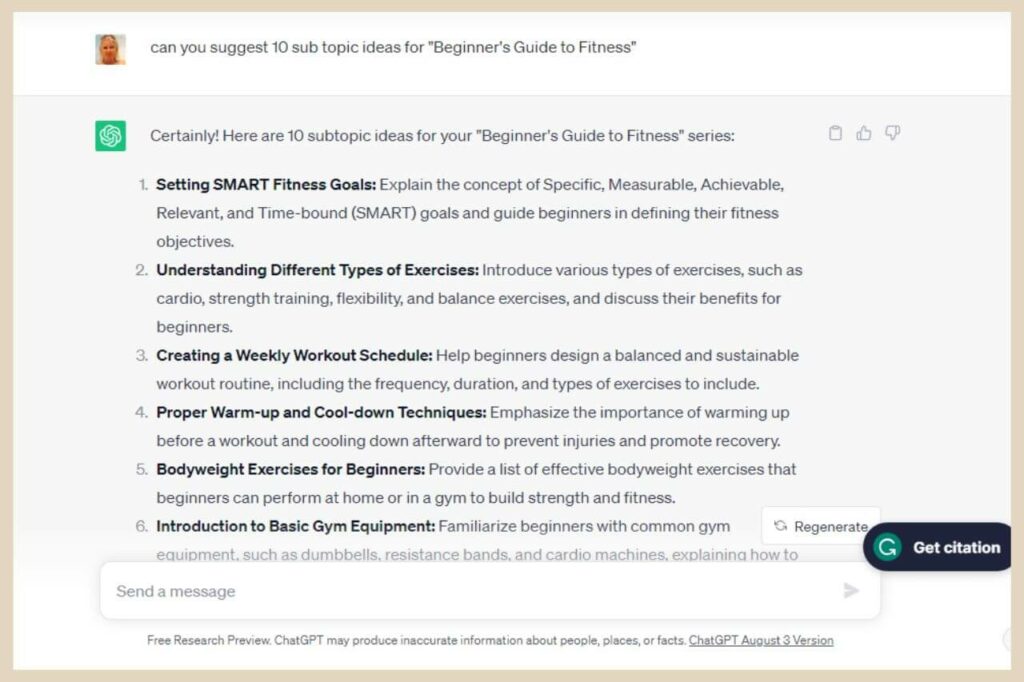
Now, if that’s not productivity on steroids, then I don’t know what is. And we haven’t even gotten to the blog post yet!
If you’d like a full walkthrough of brainstorming with ChatGPT then check out my next post.
Create Blog Post Ideas
Let’s take things up a notch and get some blog post ideas for all those topics that we’ve (“ChatGPT aka Gary”) just come up with.
Again, the easiest way to do this is one at a time for each sub-topic so your prompt would look something like this.
Can you suggest 10 blog post ideas for the sub-topic “Name of Sub-topic Idea No.1”?
Now, as you can imagine, this is going to end up being a serious amount of blog post ideas if you do this all in one go.
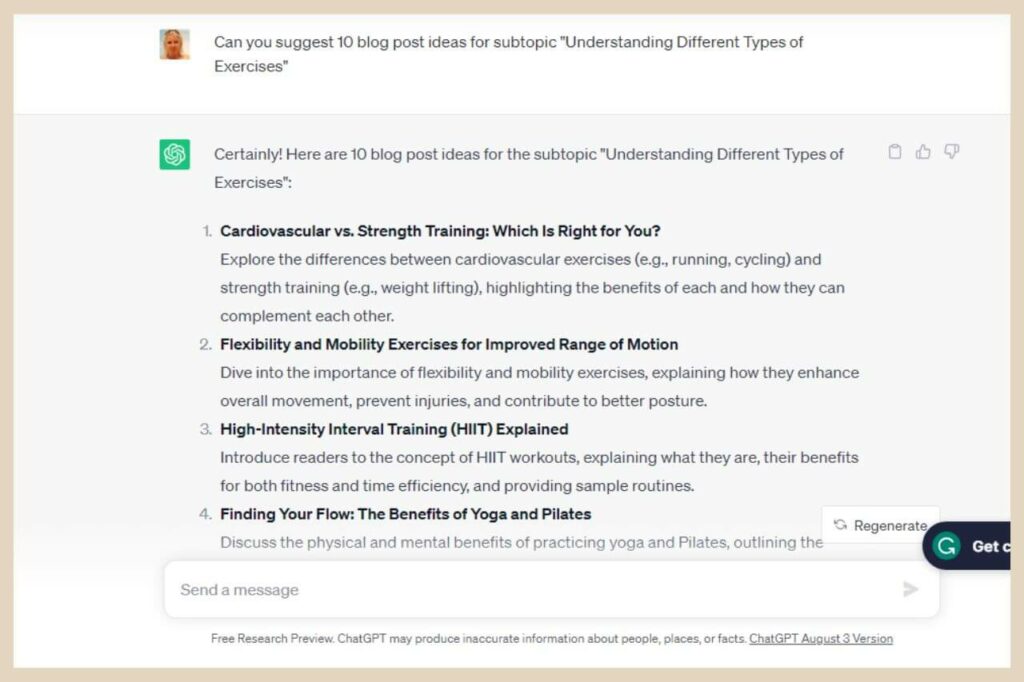
If you’ve used the x10 method here and you’re asking for 10 blog post ideas for each sub-topic (remember, in this example, we’ve got 100 of them), then that equates to 1000 blog post ideas!
Hence the reason why you need to have a Google Doc or Sheet to hand, you’re about to be doing a serious amount of coping and pasting to keep up with all these ideas.
Create Your Ideas One Section At A Time
To keep yourself from suffering complete and utter content overload, it’s probably best to copy all the topic and sub-topic ideas across to a Google Doc or Sheet and then just pick one sub-topic to work on at a time.
This way you can work on covering all aspects of that sub-topic before moving on to the next one which can help you build topical authority in those topics.
By the way, if you’re ever unsatisfied with any of the responses you get from ChatGPT, you can simply click the Regenerate button near the bottom of the page and it will regenerate a bunch of new suggestions.
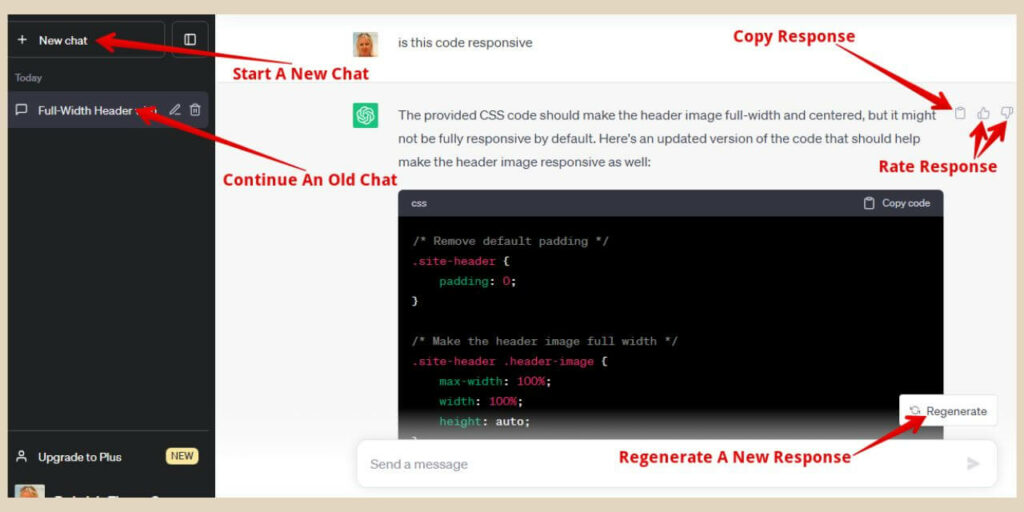
There’s also a Copy button on the top right of every response it gives you as well as a thumbs up and a thumbs down button if you feel like rating the responses.
And whenever you want to start a brand new chat on something different, you can click the New Chat button on the top left-hand side of the page to start a new discussion.
All your previous chats will still be accessible from the left pane if ever you want to jump back into them.
Create Topic Clusters
Before we move on to creating actual blog posts, there is something else that you can do here with all these ideas and that’s asking ChatGPT to come up with topic clusters.
Topic clusters are clusters of posts that all closely relate to each other but dig deeper into more specifics of the initial main topic idea.
So, for example, with the fitness blog we’re using for all our examples, cardio could be the main cluster topic and you would have a main post (which is called pillar content) all about cardio.
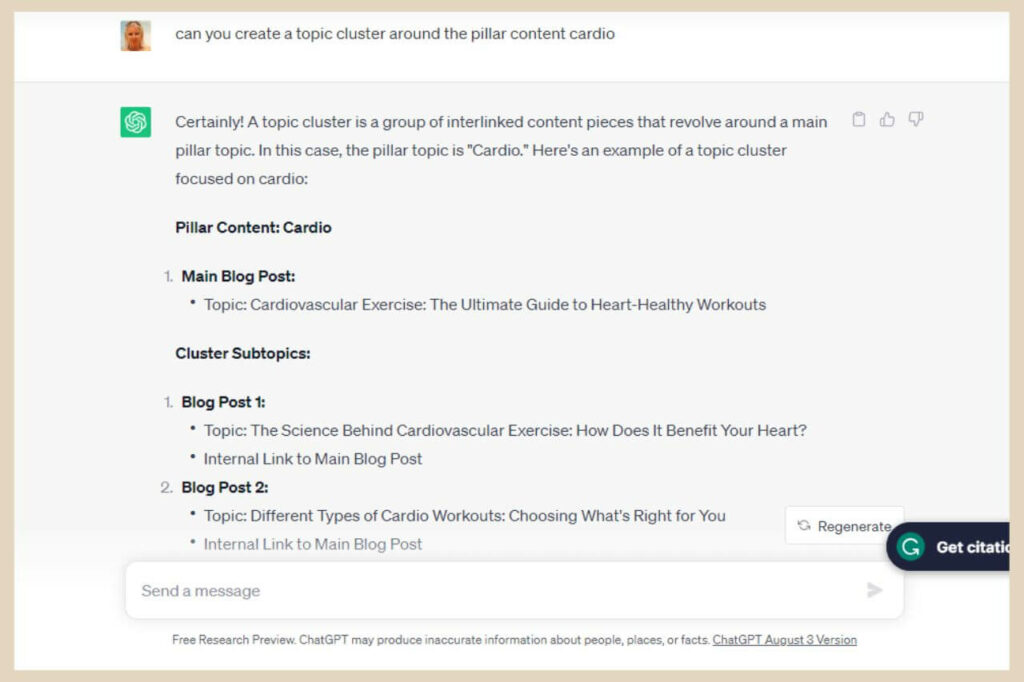
You would then create a series of cluster posts that dive into more specifics such as “cardio for beginners” and “cardio without equipment” and so on.
All of these posts would internally link back to the main pillar content (the main cardio post) and to each other creating a topic cluster which again can help with topical authority and SEO.
To get ChatGPT to help you with this, you would use a prompt that looks something like this.
Can you create a topic cluster around the pillar content cardio?
You could use a topic, sub-topic or even one of the blog post ideas as the pillar content here to create topic clusters.
Also, if you already have keywords in mind, then you could ask ChatGPT to include them by simply adding “including the keywords, [your lists of keywords]” to the prompt above.
Create Blog Post Titles
Let’s go back to the blog post ideas that ChatGPT just gave us. It will already do a pretty good job at coming up with catching titles but if you want more suggestions, you can ask it to generate more for each of the blog post ideas it’s given you.
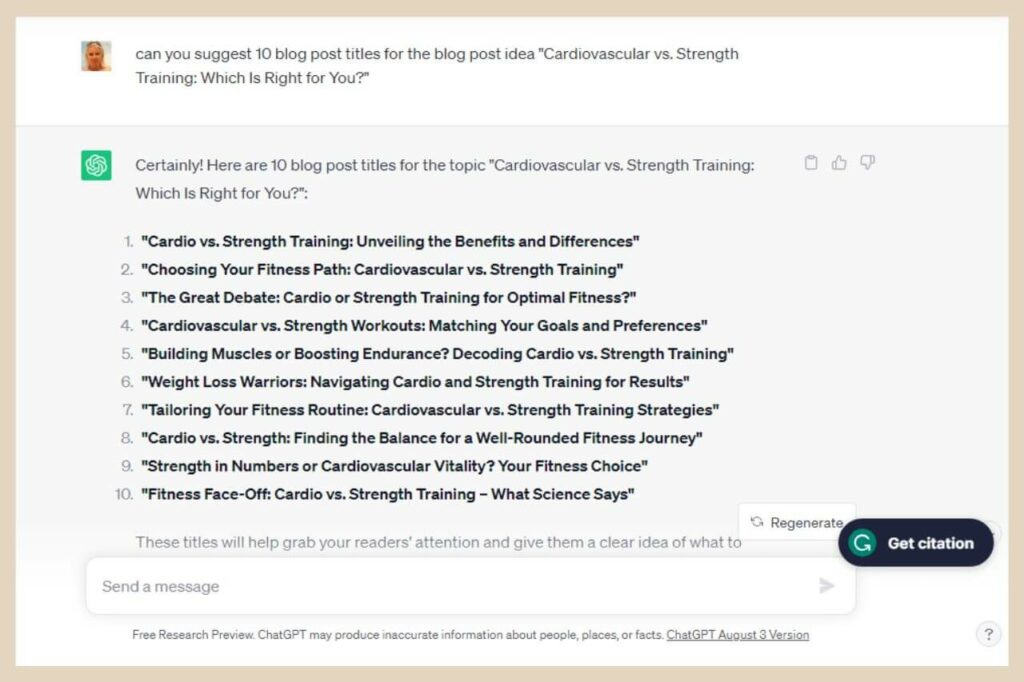
To do that, simply pick the blog post idea you like the sound of and ask ChatGPT to suggest more titles for it. The prompt in this case would look something like this.
Can you suggest 10 blog post titles for the blog post idea “Name of the blog post idea”?
Again, if you already have a keyword ready that you want to target, you can include that by adding “including the keyword [your targeted keyword]” to the end of the prompt.
ChatGPT won’t always get it spot on with the exact keyword in every blog post title idea but it does do a pretty good job even if it just gives you some title ideas that you can then play around with.
Keyword Research
So, ChatGPT won’t replace your keyword research tool just yet but it can come up with plenty of keyword ideas relating to the post idea you’d like to work on.
It doesn’t have the important metrics that you’d usually use to select your winning keywords so you’ll still need to pop them into your keyword research tool to check their validity but it certainly takes the time out of coming up with keywords the way we usually would.
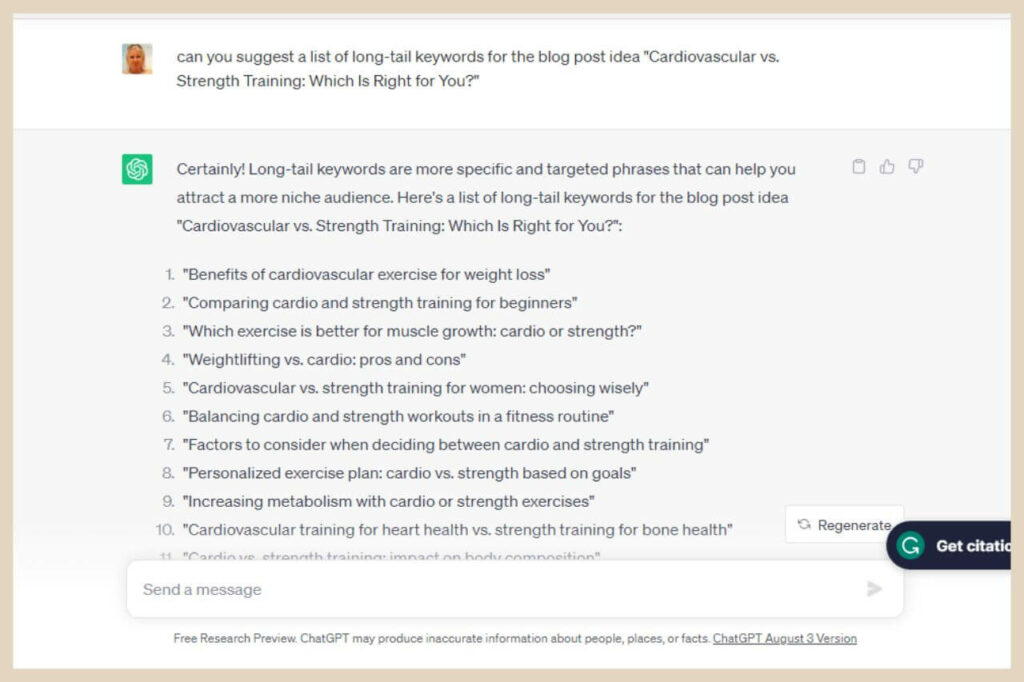
To get ChatGPT to help you with this, you would use a prompt that looks something like this.
Can you suggest a list of keywords for the blog post “Title of the blog post”?
To get even more specific, you can add the term, “short-tail keywords” or “long-tail keywords” to the prompt depending on the type of keywords you’d like it to generate.
Create A Blog Post Outline
So, now that you have a sea of ideas for all your future content, it’s time to start creating a blog post outline.
ChatGPT will usually generate an outline that includes an introduction, 6 to 10 (roughly, depending on the topic) main headings with some bullet points of the content that could be covered in each section and a conclusion.
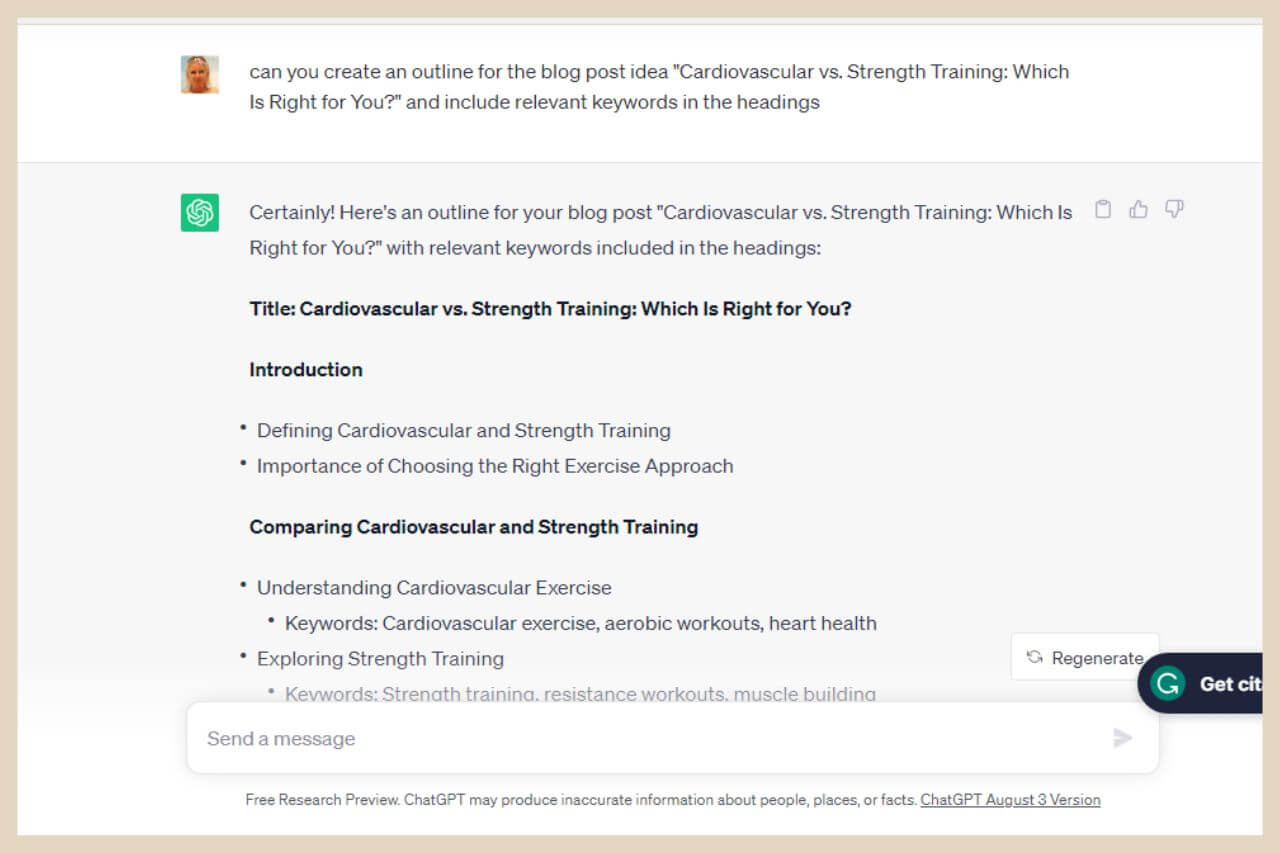
So, once you’ve decided on which post you’d like to work on, simply ask ChatGPT to create an outline for you. The prompt here would look something like this.
Can you create an outline for the blog post idea “Name of blog post idea”?
If you’d like to be more specific, you can ask for a certain number of headings or ask it to include relevant keywords (or a list of keywords you already have) in the headings. The more precise you are with your prompts, the better the results.
Create An Entire Blog Post
Now that you have your blog post outline, you can now ask ChatGPT to write the post for you. Now there are several things that you need to take into account here when using it to create entire blog posts.
Firstly, it doesn’t have your voice or writing style. Secondly, it doesn’t always have its facts straight and thirdly, you may well be committing plagiarism. It did just get all its ideas from existing content on the internet after all.

Oh and in case you didn’t know it already, ChatGPT likes to repeat itself, A LOT. This is AI-generated content after all so it will read very differently from your usual content which your readers may notice.
So with that in mind, don’t just copy and paste the content that ChatGPT produces. You’ll need to fact-check it, edit it and add your voice to it to give it that human element and most importantly, make it uniquely yours.
You can also use the free Grammarly Plagiarism Checker to make sure your finished content is completely unique and plagiarism-free.
Still, the fact that it can generate a draft copy of a post that could be several thousand words long is still a serious time saver and not something to be sniffed at.
Build Your Post One Section At A Time
Unfortunately, ChatGPT is not good at long-form content so the best way to do this is one section at a time. If you ask it to generate the entire post in one go, you’ll probably only get about 500 words out of it.
So, start with the introduction first and then move on to each heading section one by one to get the most comprehensive draft copy.
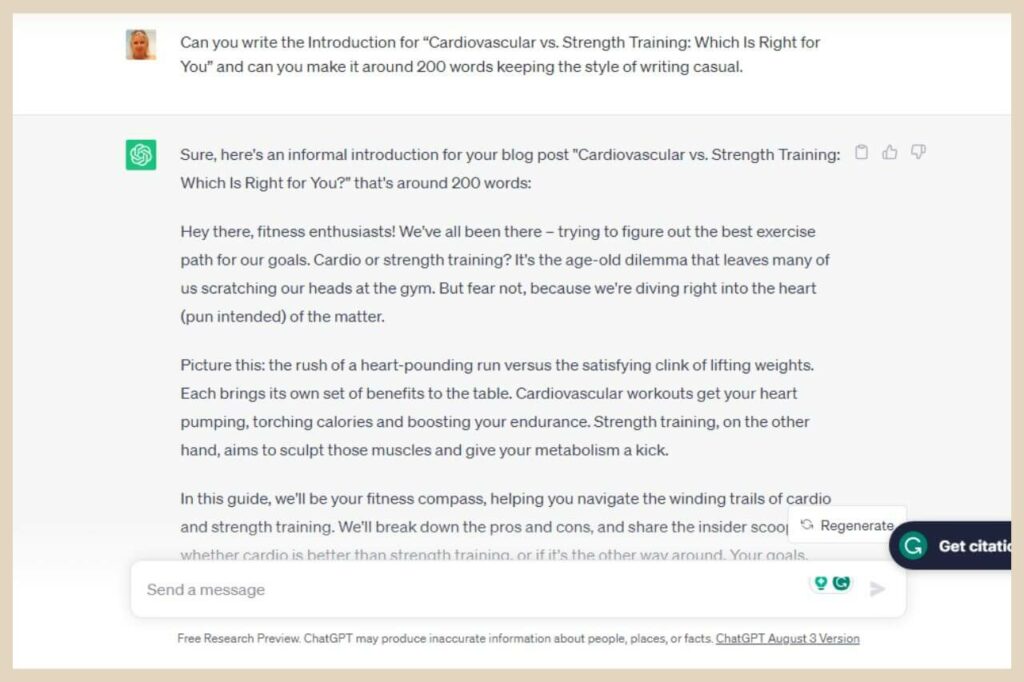
I personally like to include a specific number of words and a writing style in my prompts so they usually end up looking something like this.
Can you write the Introduction for “Name of blog post” and can you make it around 200 words keeping the style of writing casual?
Be warned though, if you ask it to keep the writing casual, it can sometimes get a little sassy so prepare yourself! ?
Anyway, You can then move on to the next sections and use a prompt like this all the way down to the conclusion.
Can you now proceed with the next section “Name of next section” and can you make it around 200 words keeping the style of writing casual?
Of course, you can change the number of words and writing style to your liking but once you’ve finished, you’ll now have a draft of a blog post that you can now edit to your own liking to make it uniquely yours.
In this particular case, ChatGPT gave me 10 headings, the introduction and the conclusion so that’s 12 sections in total. So at 200 words per section, that’s roughly a 2400-word blog post draft created in mere minutes. Now that’s what I call seriously productive!
For a full walkthrough on using ChatGPT to create entire blog posts, check out my full walkthrough post here.
Create An FAQ (Frequently Asked Questions)
FAQs (Frequently Asked Questions) are becoming a more and more popular addition to many blog posts particularly because they’re great for SEO and they help Improve your chances of being featured in Google’s Featured Snippets.
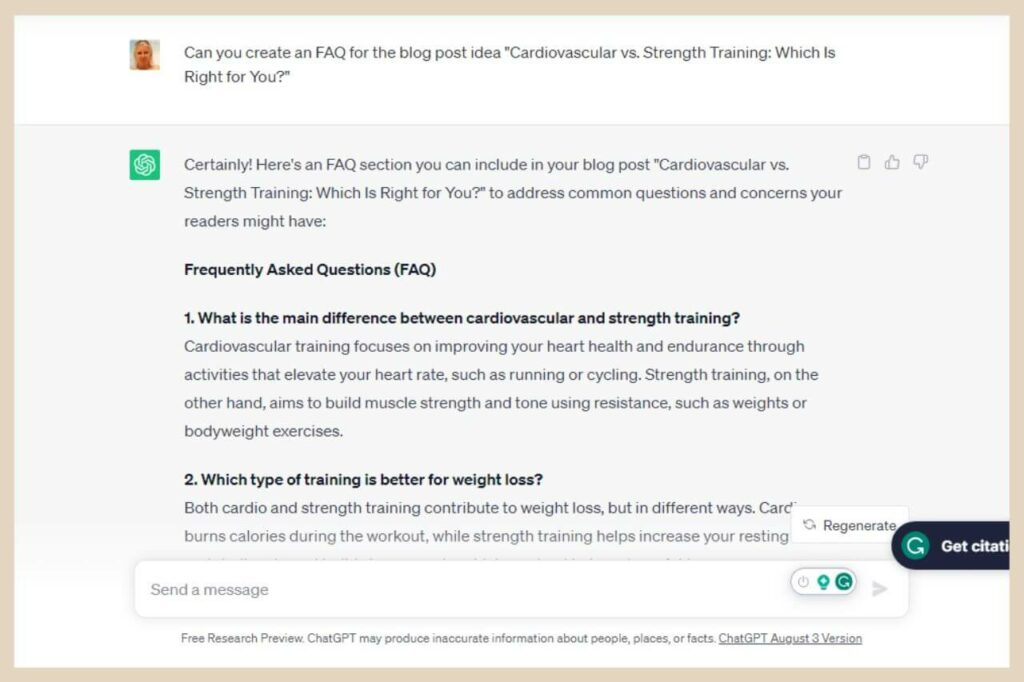
If you’d like to include an FAQ within your post then you can ask ChatGPT to help you with that too. Simply ask it to create an FAQ for your post using a prompt like this.
Can you create an FAQ for the blog post “Name of the blog post”?
ChatGPT will now come up with popular questions and their answers relating to the topic of your blog post which you can then tweak to your own liking and add to your content. These FAQs can also help with content ideas because you can expand on them with full posts
Create A Content Calendar
Now that you have all these content ideas at your fingertips, how about asking ChatGPT to create a content calendar to help keep you organised with your publishing schedule?
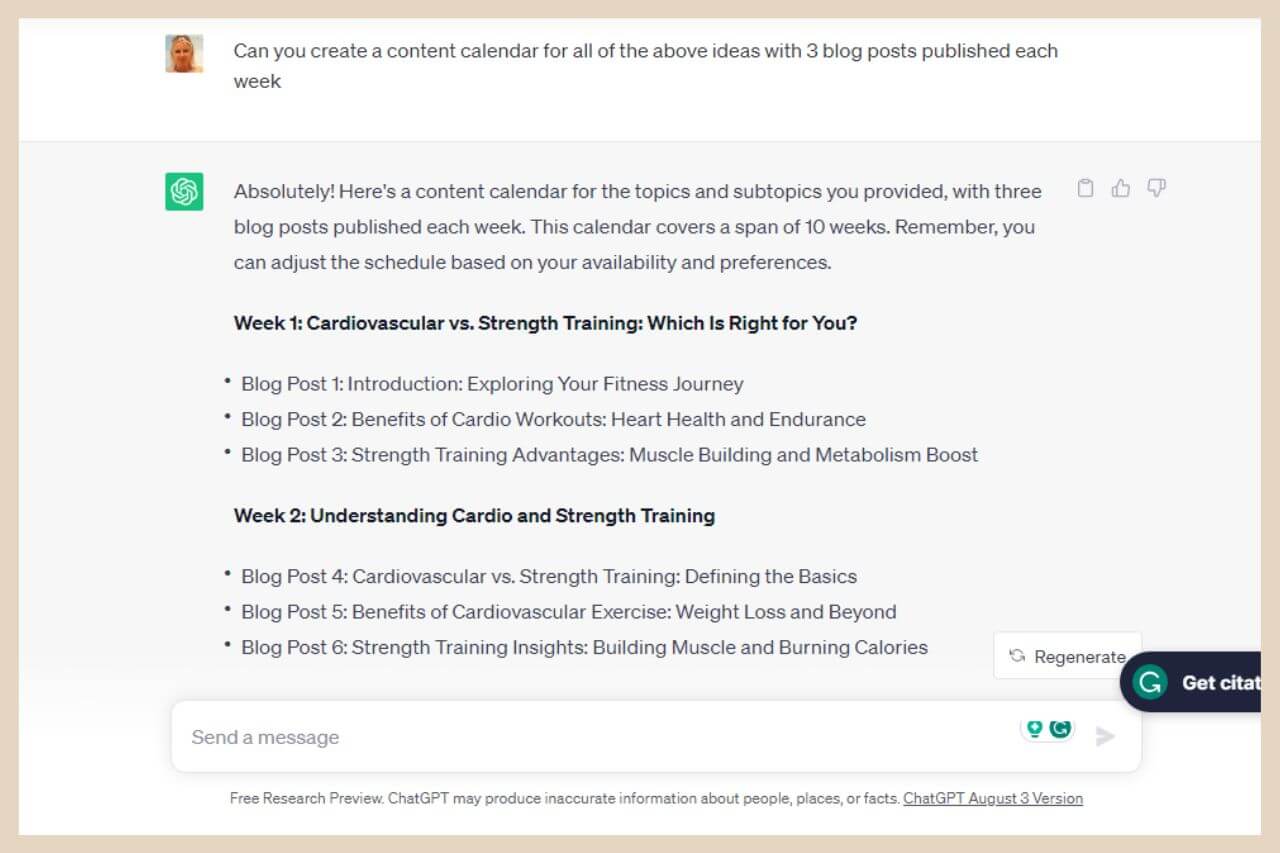
To do this, simply use the following prompt with a list of all your future blog posts included beneath it (or all the ideas it just gave you as I did in the screenshot above) and include the posting frequency that you’d like ChatGPT to apply to the calendar.
Can you create a content calendar for the following blog posts with 3 blog posts published each week? “Add your list of blog posts”?
ChatGPT will now generate a content calendar for you with a list of blog posts broken down across numerous weeks.
So not only has it given you an exponential amount of blog post ideas but it’s also organised them into a publishing schedule to keep you organised for months.
Use ChatGPT For SEO (Search Engine Optimisation)
There are a few areas where ChatGPT can step in to assist you with your on-page SEO efforts and the first one is helping you create your Meta Descriptions.
You can either just include the name of your blog post or if you want to be even more precise, you could paste your finished blog post into ChatGPT and ask it that way.
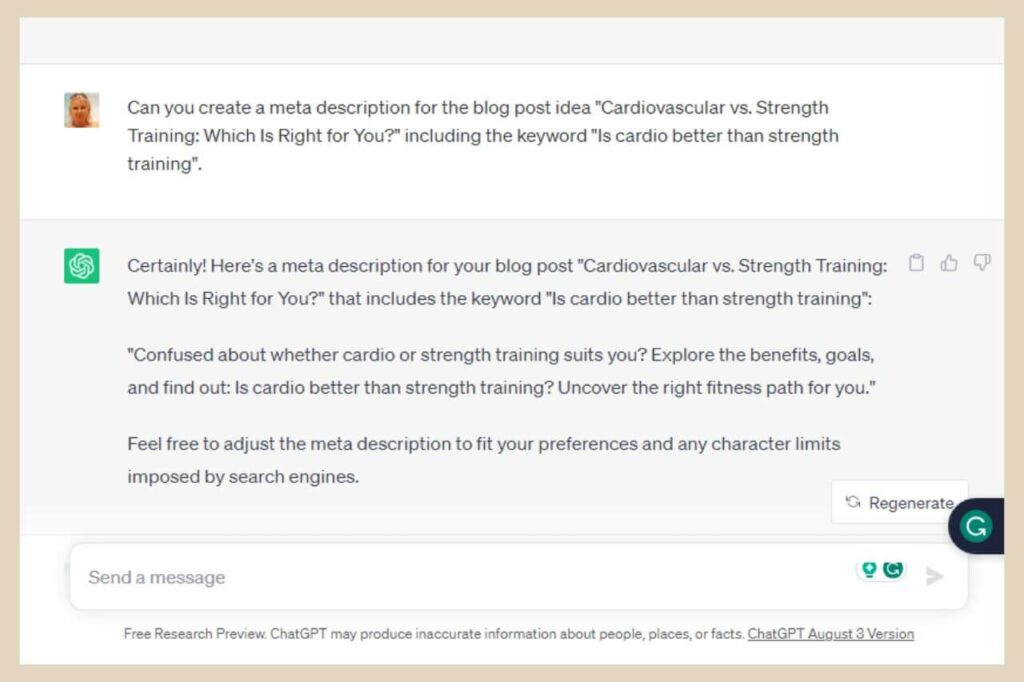
If you want to stay below a certain character limit then include that information as well as the keywords you’d like included in the descriptions. Your prompt would look something like this.
Can you create a meta description no longer than 160 characters for the blog post “Your blog post name” including the keyword “Your keyword or list of keywords”?
OR
Can you create a meta description no longer than 160 characters for the following blog post including the keyword “Your keyword or list of keywords”? “Paste your finished blog post”.
Creating Image Alt Text
The second one is helping you create alt text for your images. For this prompt, you’ll need to describe the image and ask ChatGPT to include any keywords you’d like added to the text.
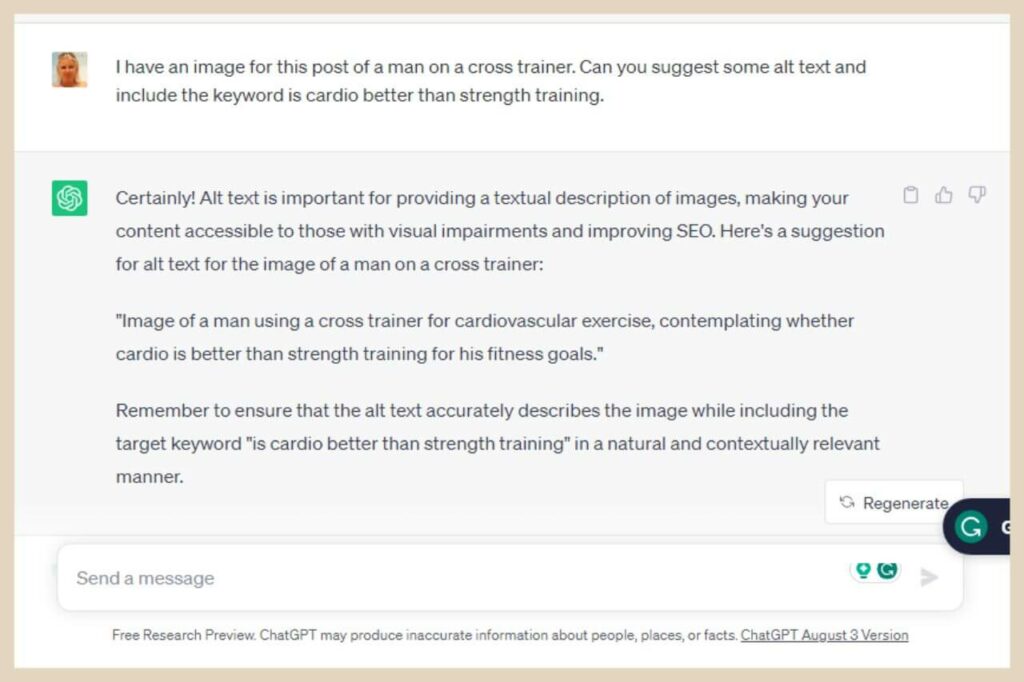
You should end up with a prompt that looks something like this.
I have an image of “Describe your image”. Can you suggest some alt text and include the keyword “include your keyword or list of keywords”?
Suggesting Internal Linking Opportunities
The third one is asking it to suggest internal linking opportunities within your content. Again, you can just include the name of your blog post for this task using a prompt like this.
Can you suggest any internal linking opportunities for the blog post “Name of the blog post”?
For more precise suggestions, you can paste your entire finished blog post into the prompt so your prompt would look more like the following.
Can you suggest any internal linking opportunities within the following blog post? “Paste your finished blog post”.
With the first method, ChatGPT will use the topic of the blog post to suggest sections of content to include and topics you can then link out to from those sections which gives even more content ideas both for the current post and new posts to link to.
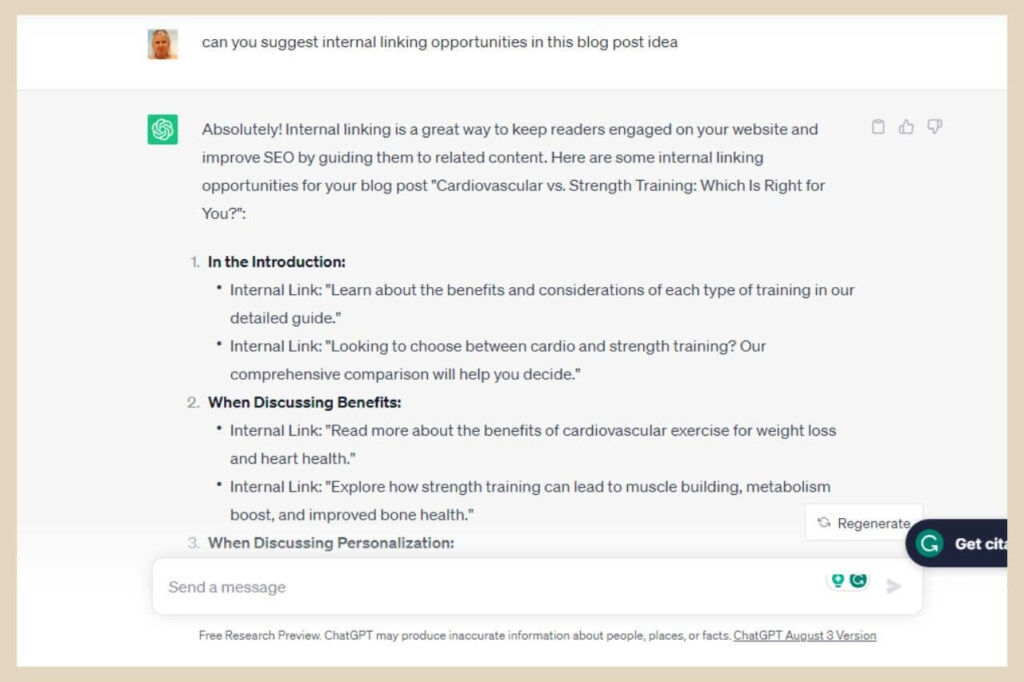
The second method of pasting your finished blog post into the prompt will give you suggestions based on sections of your actual written content.
It will suggest where you can place internal links within your existing content and post ideas that you could link out to so both ways are great for generating even more ideas.
Creating Your Social Posts
Much like using ChatGPT to help with your blog posts, you can also use it to help with your social posts.
Simply ask it to create a tweet, a Facebook post, a Pinterest pin description, etc. for the blog post you’re about to share.
Can you create a “Name of social media post type” for the blog post “Name of blog post”?
You can also ask it to include keywords, hashtags or anything else that you think is relevant. It can even come up with catchy headlines that you may never have thought of to make your social posts even more enticing to your followers and anyone else who sees them.
I’ve been using it to help create Pinterest pins and I have to say, it’s proving to be a seriously helpful and time-saving tool for all my pinning needs.
Help With Answering Your Comments
So, you’ve received a comment and for one reason or another, you’re struggling to come up with an appropriate response. Well, ChatGPT can once again lend a helping hand here.

Just paste the comment in question into ChatGPT and ask it to come up with some response suggestions using a prompt like this.
Can you suggest a response to the following comment that was left on the blog post “Name of blog post”? “Paste the comment”.
Sometimes this prompt alone will work just fine but if you want to be even more precise, you could add some details on what the post is about or even paste the entire blog post here to give ChatPGT more info to work with. For that, you’d use a prompt like this.
I have just received a comment on the following blog post, “Paste full blog post”. Can you suggest a response to this comment, “Paste the comment”?
Again, don’t just copy what it outputs verbatim, you’ll need to edit it and make it more human with your own voice but it can certainly help you out when you find yourself in one of those “I’m not sure how to respond to that” situations.
Help With Your Email Campaigns
Much like comments, ChatGPT can help you when you get writer’s block answering emails but it can even help you create entire email campaigns.
Whether that be newsletters or content announcements, our chatty friend is very good at coming up with entire email ideas just from the title of a blog post.
It also does a very good job of creating highly intriguing subject lines that might just help improve your opening and click rates.
Competitor Analysis And Identify Content Gaps
ChatGPT is a very handy tool when it comes to competitor analysis and identifying content gaps and the best part is that it can do it in a matter of seconds.

Simply paste the competitor’s blog post into ChatGPT and ask it to identify any content gaps within the article using a prompt like this.
Can you analyse the content gap of the following blog post, “Paste the competitor’s blog post”?
It will immediately list off areas that have been missed or only briefly touched upon which you can then use to make your own blog post even more comprehensive.
You can also ask it to list all the keywords within the competitor’s post to help you improve your own SEO and ranking potential.
Improving Your Own Content
Much like how you’d identify content gaps in your competitor’s post, you can use this same technique to analyse and improve your own content.
Just paste your own content in the same way and ask it the same question to identify any areas that you may have missed or not covered enough.
You can even ask it for more keyword suggestions or general suggestions to help with readability, consistency, tone, flow etc. You name it, ChatGPT can help you improve it and all you need to do is ask.
Other Helpful Uses Of ChatGPT For Blogging
If everything I’ve just mentioned above isn’t enough, there’s still more that ChatGPT can do to make your blogging life easier. Need help coming up with a Domain name? Check. Do you need help with code snippets? Check.
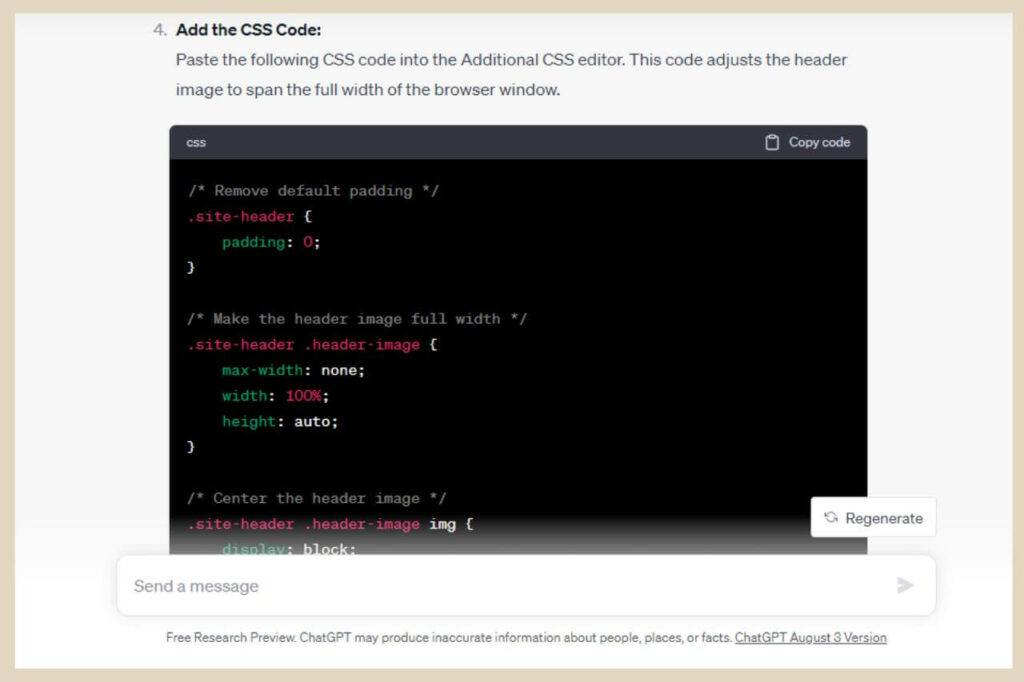
Need help with the script for your next YouTube video? Check. Need help refreshing and updating old content? Check.
You can even tell it all about your business to help you get better and more accurate results. It really is a tool that can assist in so many ways that it’d be hard to find a reason not to use it.
ChatGPT Frequently Asked Questions
What Is ChatGPT And How Can It Help With Blogging?
ChatGPT is an AI-powered language model developed by OpenAI. It can assist bloggers by generating content ideas, blog post outlines, titles, meta descriptions, and even entire blog posts. It’s a valuable tool for brainstorming, optimizing content, and enhancing your blogging process.
Is ChatGPT Free To Use?
Yes, there is a free version of ChatGPT (GPT-3.5) available for users. It provides valuable functionalities for most bloggers, including topic generation and content creation. However, there’s also a paid version (GPT-4.0) that offers additional features and capabilities.
Is The Free Version Of ChatGPT Sufficient For Blogging?
Yes, the free version (GPT-3.5) offers a wide range of capabilities suitable for most bloggers.
advertisement
While the paid version (GPT-4.0) provides additional functionality, the free version is more than adequate for generating ideas and drafting content and it can do everything mentioned in this post.
Is ChatGPT Easy To Use?
Yes, ChatGPT is incredibly easy to use. It has a simple user-friendly interface so even complete beginners will find it a breeze to use. Just type your question (prompt) into the text box and ChatGPT will do the rest.
Can ChatGPT Help With Keyword Research?
Yes, ChatGPT can suggest a list of keywords related to your blog post title or topic. While it doesn’t replace traditional keyword research tools, it streamlines the process by generating relevant keyword ideas.
Can ChatGPT Help With SEO?
Absolutely! ChatGPT can assist with keyword research, suggest internal linking opportunities, and even help with creating meta descriptions for your blog posts. While it’s not a replacement for dedicated SEO tools, it can certainly enhance your SEO efforts.
Can ChatGPT Help Improve My Existing Content’s Quality?
Yes. ChatGPT can analyse your content, identify gaps, suggest improvements, and even generate alternative phrases or sentences.
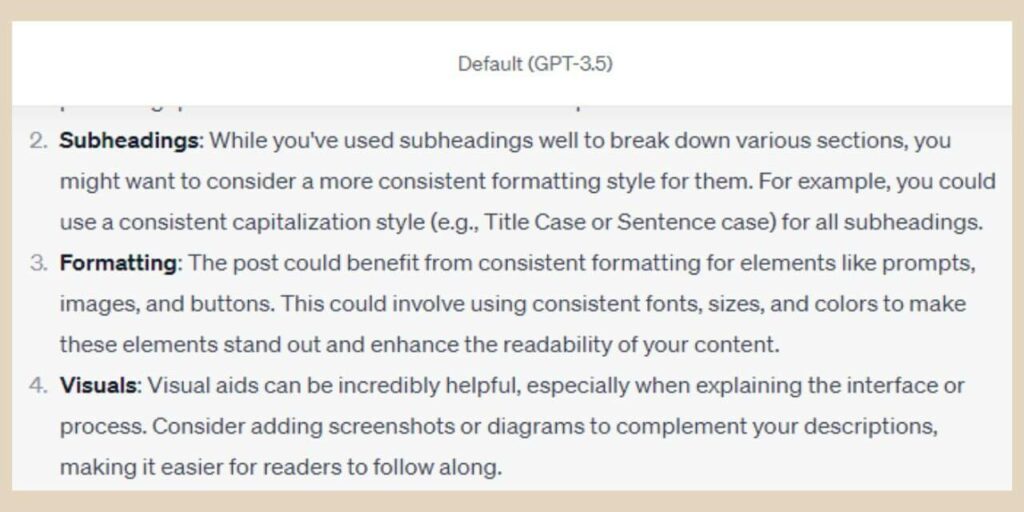
It’s a valuable tool for enhancing readability, consistency, tone, and flow in your writing. It will even offer formatting, image and layout suggestions.
Can ChatGPT Create Entire Blog Posts?
Yes, ChatGPT can generate draft copies of blog posts, but there are a few caveats. It lacks your writing style and voice, might contain inaccuracies, and could inadvertently lead to plagiarism.
It’s recommended to use ChatGPT as a starting point and then edit, fact-check, and personalize the content. It also can’t produce long-form content so for best results, tackle each heading/subheading one at a time.
Can ChatGPT Replace Human Creativity?
While ChatGPT is a powerful tool, it doesn’t replicate human creativity and voice. It’s essential to review, edit, and personalize the content it generates to infuse it with your unique style and perspective.
Can ChatGPT Be Used For Social Media Posts?
Yes. You can ask ChatGPT to create engaging social media posts, including tweets, Facebook updates, and Pinterest pin descriptions.

It can suggest catchy headlines, incorporate keywords and hashtags and help you craft compelling and attention-grabbing content for your social platforms.
Can ChatGPT Help With Competitor Analysis?
Yes, ChatGPT can assist in identifying content gaps in competitor articles. By pasting a competitor’s content, you can prompt ChatGPT to suggest areas that can be expanded upon or covered in your own blog post.
Can ChatGPT Create Content Calendars?
Absolutely! You can ask ChatGPT to generate a content calendar based on your list of blog posts and desired posting frequency. It’s a great way to stay organized and plan your publishing schedule.
Can I Use ChatGPT For Email Campaigns?
Yes, ChatGPT can help create email campaign content, including subject lines and email body text.

However, much like any content generated within ChatGPT, always personalize and edit it to align with your brand’s voice and message.
Are There Any Limitations To Using ChatGPT?
ChatGPT’s content may lack your unique voice, occasionally contain factual errors, and could lead to unintentional plagiarism. It’s important to review, fact-check, and add your personal touch to the content it generates.
How Do I Get Started With ChatGPT?
To begin using ChatGPT, create an account at chat.openai.com. You can use either the free version (GPT-3.5) or the paid version (GPT-4.0) to start exploring its various features and capabilities.
Let’s Get Chatting With ChatGPT
And there you have it, a game-changing tool that can help you with almost every single aspect of your blogging journey.
As you move forward, crafting your content plan, diving into keyword research, and constructing captivating outlines, ChatGPT will be ready to lend its helpful digital hand.
But, as with any tool, understanding its strengths and limitations is key. Leverage ChatGPT to brainstorm, inspire, and generate ideas, but sprinkle in your own authentic touch to truly connect with your audience.
Whether you’re a seasoned blogger seeking new strategies or a novice ready to conquer the digital landscape, use ChatGPT as your ally to open up a whole new way of creating content.
So how have you been using yours and did you give it a name of its own? I’d love to hear all about it so don’t be shy and use the comments section below to tell me all about your ChatGPT adventures, the good, the bad and utterly mind-blowing!
Happy Chatting With ChatGPT!

You May Also Like
- How To Display Recent Posts With Thumbnails In WordPress
- How To Add An Affiliate Disclosure To Your Posts
- What Is Wealthy Affiliate – Everything You Need To Know

